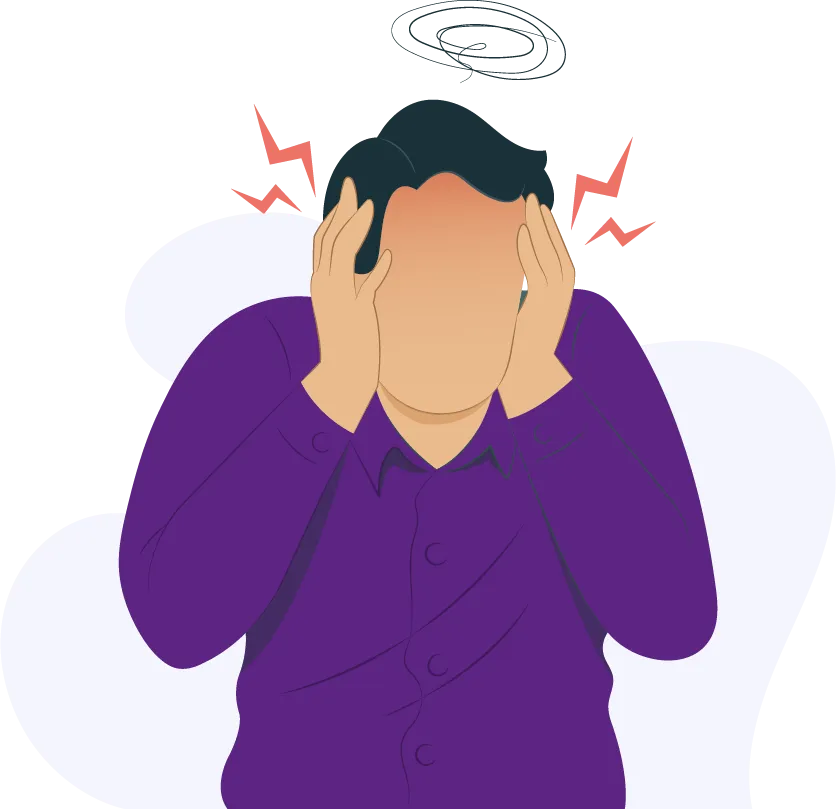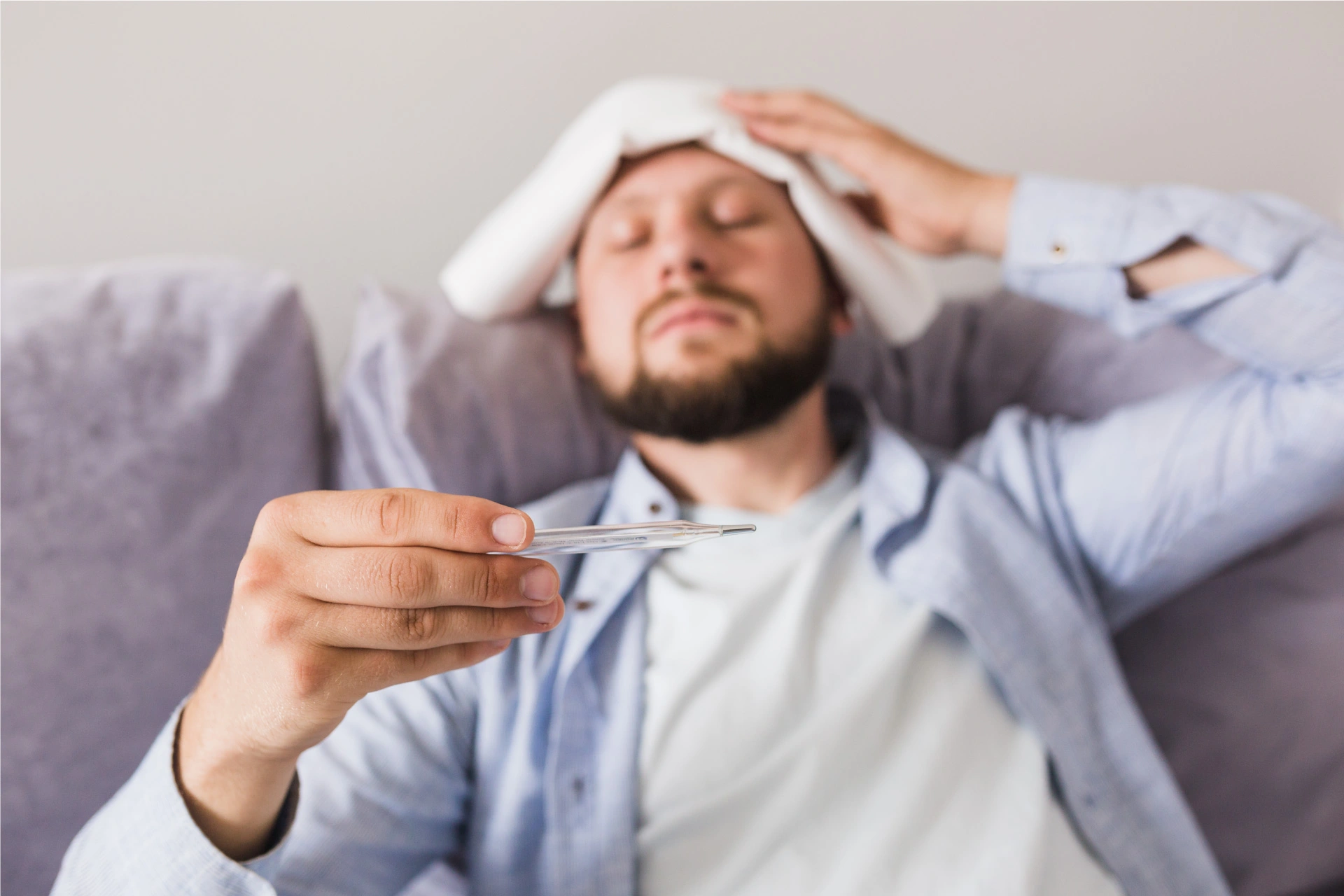Family Medicine | 10 min read
Migraine: Symptoms, Triggers, Treatment, Risk Factors
Medically reviewed by
Table of Content
Key Takeaways
- Migraine headaches are common headaches that can cause severe pain, nausea, and vomiting
- There are many treatments for migraine headaches, including over-the-counter and prescription medications.
- A migraine can be an extremely unpleasant condition to have and its symptoms can disrupt daily life and work.
A migraine may be thought of as a severe headache affecting one side of the head but is, in fact, a neurological disease whose symptoms can be incapacitating and of a much greater intensity than those of a bad headache. As a disease, migraine is very common in India, with over 10 million cases annually. According to the Migraine Research Foundation, migraine is the 3rd most widely spread disease worldwide and, also, the 6th most disabling illness globally.
Suffering from a migraine headache is not easy, and, often, having a migraine causes one to become sensitive to light and feel nauseous. Hence, it is common for people with migraines to seek dark rooms. Despite that the fact that migraines inflict much pain, the disease is not very well understood, and moreover, many go by without seeking medical aid. As of now, there is no known migraine cure. But there are migraine treatment options that aim at reducing migraine symptoms. Moreover, it is possible to identify potential triggers for the condition and adopt some home remedies for immediate relief.
Learning about migraines can help you be more effective in your approach towards handling it and assist those suffering from it. To that end, here is a rundown on migraines.
What is Migraine?
A migraine is a neurological disorder, as per recent research. It is a type of headache that recurs and though it often causes pain or throbbing on one side of the head, it is known to affect both sides as well. Many a time, it is hard to word a concise definition of a migraine, meaning that even doctors may differ in their responses. Nonetheless, the American Migraine Foundation notes that for a clinical definition of migraine, the following suffice:
- At least 5 attacks of unprovoked headaches
- The headaches last for 4 to 72 hours
- The attack is severe enough to markedly hinder or prohibit routine daily activity
- Alongside the headaches are the symptoms of nausea and sensitivity to light/ sound
The clinical definition of migraine makes no mention of pulsating headaches or the symptom called migraine ‘aura’. Moreover, not every migraine is severe and incapacitating. So, to know whether you are suffering from migraine headaches it is apt to take a look at a list of the most common migraine symptoms.
Migraine Symptoms
Migraine is a debilitating condition that can cause severe head pain and other symptoms. While the exact cause of migraines is still unknown, certain triggers can bring on a migraine attack. These triggers can vary from person to person, but some common triggers include the following:
- Stress
- Changes in weather or barometric pressure
- Bright lights or loud noises
- Certain foods or drinks
- Hormonal changes
During a migraine attack, you may experience symptoms such as:
- Severe head pain that is throbbing or pulsing
- Sensitivity to light and sound
- Nausea and vomiting
- Visual disturbances
- Vertigo or dizziness
Common migraine symptoms include throbbing pain on one side of the head (though both sides are affected in about 33% of cases), nausea, and

Four Stages of Migraine
A migraine is a common headache that can cause severe pain, nausea, and vomiting. There are four main phases of a migraine:
Prodrome (up to 24-48 hours before the headache)
This phase starts one or two days before the migraine headache. Symptoms during this phase may include changes in mood, neck stiffness, and impaired concentration.
These are early signs of a migraine headache and include:
- Mood changes
- Low energy or fatigue
- Hyperactivity
- Stiff neck
- Fluid retention
- Increased urination
- Increased thirst
- Constipation
- Uncontrolled yawning
- Irritation
Aura
The migraine aura is sensory disturbances that may occur before or during a migraine, although not everyone experiences them. An aura can be viewed as a warning sign of a migraine. They last for 20 to 60 minutes. The symptoms of aura (sensory disturbances) include:
- Seeing bright dots, sparks, flashes of light, zig-zag lines, etc.
- Loss of vision for a short period of time
- Muscle weakness
- Uncontrolled jerks/ movements
- Tingling sensation at the face, arms, legs, fingers, etc.
- Numbness in the face, arms, legs, or one side of the body
- Speech difficulties, such as slurring and the inability to speak the right words
- Hearing sounds
Attack
This is the most intense of the migraine phases and may be accompanied by an aura. The symptoms, which may last for hours to days and increase in intensity, include:
- Throbbing or pulsating pain
- Pain on one side of the head, though not always
- Sensitivity to light/sound/ smell
- Nausea and vomiting
- Faintness or dizziness
An important thing to remember here is that not every migraine causes a headache.
Postdrome (Post the migraine attack)
This phase occurs after the migraine headache has subsided. Symptoms during this phase may include fatigue, mood changes, and impaired concentration.
After a migraine attack, certain symptoms linger for up to 24 hours. These include:
- Weakness
- Exhaustion
- Mild headache
- Mood changes
- Confusion
- Pain on head movement
Types of Migraines
There are several different types of migraines, each with its unique symptoms. The most common type of migraine is called a “migraine with aura”. This type of migraine typically consists of a severe headache followed by visual disturbances (aura). Other common migraine symptoms with aura include nausea, vomiting, and sensitivity to light.
Another type of migraine, called a “migraine without aura”, is less common than a migraine with aura. This type of migraine typically consists of a severe headache but does not include aura or other visual disturbances. Other common symptoms of a migraine without aura include nausea, vomiting, and sensitivity to light.
Migraines can also be classified as “hemiplegic” or “basilar-type”. These types of migraines are much less common but can be very severe. Hemiplegic migraines typically cause paralysis on one side of the body, while basilar-type migraines typically cause dizziness, vertigo, and other neurological symptoms.
If you are suffering from migraines, it is important to see a doctor to find out which type you have. Depending on the type, treatment for migraines may include medication, lifestyle changes, and alternative therapies.
Migraine Causes and Triggers
There are several causes and triggers of migraine. Some people get migraines from certain foods or drinks, while others may be sensitive to changes in weather or stress levels. It is important to figure out what triggers your migraines to avoid them as much as possible.
There are many different theories on what causes migraines, but the most likely cause is a combination of genetic and environmental factors. If you have a family member who suffers from migraines, you may be more likely to get them yourself. Certain lifestyle factors can increase your risk, such as working long hours or not getting enough sleep.
There are several different migraine triggers, and these can vary from person to person. Common triggers include:
- Certain foods or drinks, such as aged cheese, caffeine, or red wine
- Changes in weather or barometric pressure
- Stress
- Sensory stimuli, such as bright lights or loud noises
- Hormonal changes, such as during menstruation
If you suffer from migraines, it is important to keep track of your triggers so that you can avoid them as much as possible. There are many helpful resources available, such as migraine diaries, that can help you to identify your triggers.
To date, the exact cause of migraines is not known. Research points in the direction of genetics, environmental factors, and changes in brain chemicals like serotonin. That being said, there are several triggers of migraines that you can take note of:
Hormone Changes in Women
Changes in oestrogen levels about the time of periods may be linked to migraines.
Emotional Triggers
Shock, stress, anxiety, depression, excitement, etc.
Change in Sleep Pattern
Too little or too much sleep, jet lag, poor-quality sleep
Physical Factors
Tiredness, exertion, odd work hours, bad posture
Dietary Ttriggers
Alcohol, excess caffeine, missing meals, dehydration, tyramine-containing foods, processed foods, etc.
Sense Triggers
Bright light, loud noise, smoking, weather changes, strong odour, etc.
Medication
Sleep tablets and oral contraceptives can contribute to migraines
Apart from noting these triggers, it is important to bear in mind that:
- Migraines tend to run in families
- Affect women more than men
- Have been linked to other mental conditions like depression, sleep disorder, and bipolar disorder
What Causes Migraines in Females
Migraines are a type of headache that can cause intense pain, pulsing, and other symptoms. They are more common in women than men, and their exact cause is unknown. However, there are some theories about what might trigger migraines in women.
Hormonal changes are one potential trigger for migraines. This could be due to menstrual cycles, pregnancy, menopause, or taking birth control pills. Changes in estrogen levels might play a role in migraines, as well as other factors like stress and dehydration. Another potential trigger for migraines is food. Common culprits include aged cheeses, processed meats, chocolate, and caffeine.
Risk Factors of Migraines
Migraines can be extremely debilitating and make it difficult to function daily. Many potential risk factors for migraines include family history, certain health conditions, and lifestyle choices. For example, women are more likely to experience migraines than men, and people who suffer from other conditions like depression and anxiety are also at a higher risk. Additionally, migraines can be triggered by certain foods, stress, changes in sleep patterns, and environmental factors.
Diagnosis of Migraines Headaches
A general physician diagnoses a migraine by:
- Noting the symptoms
- Checking your family history
- Conducting a physical and neurological examination
- Carrying out tests like MRI and CT scan
Then, according to the symptoms and triggers, a case of migraine may be classified according to the commonly-described migraine types such as:
- Migraine with aura
- Migraine without aura
- Silent migraine (aura without headache)
- Chronic migraine
- Acute migraine
- Vestibular migraine
- Menstrual migraine

Treatment of Migraines
Depending on the individual's needs and preferences, there are many different ways to treat migraines. For example, some people find relief with over-the-counter pain medications, while others may need prescription medications or other treatments.
Several medications are available for migraine, over-the-counter and prescription. For example, pain relievers such as ibuprofen and aspirin can be effective for some people. Other people may need to take prescription medications, such as triptans or anti-seizure medications. Some people may also benefit from preventive treatments, such as Botox injections or medications to help prevent migraines from occurring in the first place.
In addition to medications, there are a number of other treatments that can be effective for migraines. For example, some people find relief with acupuncture or massage. Others may need to make lifestyle changes, such as getting enough sleep, managing stress, and avoiding triggers such as bright lights or loud noises.
If you suffer from migraines, it's important to work with your doctor to find the best treatment plan.
In terms of migraine treatment, it is important to understand that there is no migraine cure. However, your doctor may prescribe medications such as paracetamol, ibuprofen, and anti-emetics, to manage and reduce the symptoms.
Migraine in children
Migraine is a common condition that can affect children as well as adults. Some children may also experience an aura, visual or other perceptual changes that can occur before or during a migraine attack.
There is no cure for migraine, but treatment options available can help manage the condition. If your child is suffering from migraines, it is essential to seek guidance from a medical professional to ensure they receive the best care.
Migraine Prevention
There are many different approaches to migraine prevention, and the best method for a particular individual may vary depending on the individual’s unique circumstances. However, some standard preventative measures include lifestyle changes, such as getting regular exercise, maintaining a healthy diet, and taking medications designed to prevent migraines can help.
Home Remedies for Migraines
- Lying down in a quiet, dark room
- Placing an ice pack/ cool cloth on the forehead or behind the neck
- Drinking fluids
- Massaging the temples or head
All in all, a migraine can be an extremely unpleasant condition to have and its symptoms can disrupt daily life and work. Nevertheless, treatments help in relieving the symptoms and can help you get back on your feet faster. Moreover, the migraine condition is said to improve over years. However, this may involve some active role on your part, such as lifestyle modifications to avoid the triggers of migraine headaches. Since the symptoms of a migraine are common to many other diseases and may even be mistaken for those of a stroke, it is not a good idea to take major healthcare decisions without proper counsel. Access to medical assistance is easier than ever with the healthcare platform provided by Bajaj Finserv Health. It allows you to search for relevant doctors and specialists near you, book appointments at their clinics, sign up for video consultations, store and share medical records, and play an active role in managing your overall health.
So, get in touch with a doctor to draw out a good plan to prevent possible migraine attacks! Begin your journey towards a healthier lifestyle!
References
Disclaimer
Please note that this article is solely meant for informational purposes and Bajaj Finserv Health Limited (“BFHL”) does not shoulder any responsibility of the views/advice/information expressed/given by the writer/reviewer/originator. This article should not be considered as a substitute for any medical advice, diagnosis or treatment. Always consult with your trusted physician/qualified healthcare professional to evaluate your medical condition. The above article has been reviewed by a qualified doctor and BFHL is not responsible for any damages for any information or services provided by any third party.





